Scottish Schools Adolescent Lifestyle and Substance Use Survey (SALSUS): smoking report 2018
Findings on smoking and e-cigarettes from the 2018 wave of the Scottish Schools Adolescent Lifestyle and Substance Use Survey (SALSUS).
This document is part of a collection
7 Risk factors and protective factors
The charts in this chapter show the proportion of regular smokers among different subgroups of 13 and 15 year olds. For example, the first chart in Figure 7.1 shows that 3% of 13 year olds who live with a step parent are regular smokers.
Family
A number of elements of family life were associated with regular smoking. These were: family structure, parental awareness of pupil activities, family communication and pupil caring responsibilities (Figure 7.1).
Family structure
Among 15 year olds, those living with a single parent or step-parent were more likely to be regular smokers than those who lived with both parents.
Maternal and paternal awareness
Among both age groups, regular smoking was higher among those who thought that their mother knew a below average amount about what they do and who they are with. The same pattern emerged for father’s perceived knowledge of activities.
Family communication
Across both age groups, those who said they would be likely to talk to their family if they felt worried about something, were less likely to be regular smokers than those who would not.
Caring responsibilities
Those who had caring responsibilities were more likely to be regular smokers than those who did not.
Figure 7.1: Comparison of prevalence of smoking, by factors relating to family life and age (2018)
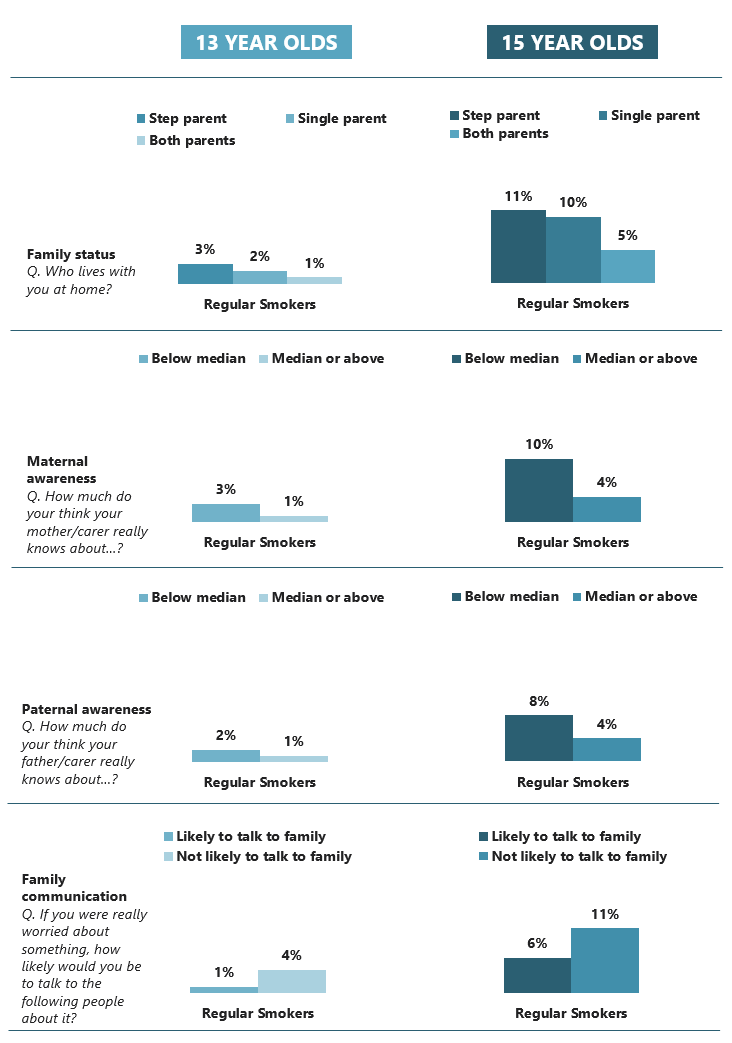
Figure 7.1 – continued – Comparison of prevalence of smoking, by factors relating to family life and age (2018)
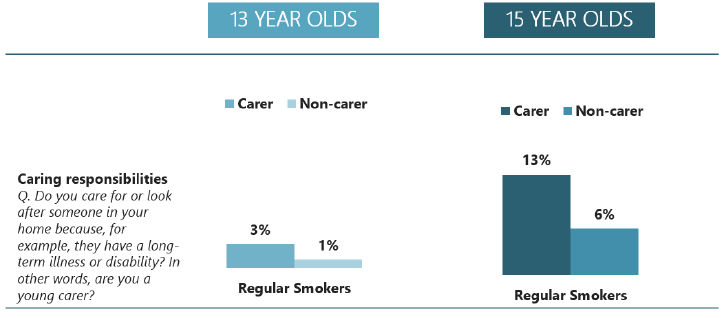
Base: all pupils (for full base sizes please see Appendix A)
Friends and leisure activities
Aspects of a pupil’s social life were related to regular smoking. These were: the number of close friends, the age of friends, the number of evenings spent out with friends, the amount of their own cash they had available to spend, and the types of leisure activities they pursued (Figures 7.2 and 7.3).
Number of friends
Pupils with no close friends were more likely to be regular smokers than those who had one or more friends.
Age of friends
Pupils with friends around the same age were less likely to be a regular smokers than those with older, younger or mixed-age friends, among both 13 year olds and 15 year olds.
Number of evenings spent out with friends
Generally, the greater the number of evenings pupils spent out with friends, the greater the likelihood that they were a regular smoker. However, there was no significant difference between the proportion of regular smokers among those who spent no evenings with friends and those who spent one or two.
Amount of own cash to spend
Pupils with more money of their own to spend were more likely to be regular smokers than those with less.
Leisure activities
15 year old non-smokers were more likely than regular smokers to frequently spend time reading books, doing a hobby or playing sport.
15 year old regular smokers were more likely than non-smokers to see friends or go to a friend’s house weekly, as well as several other activities such as hanging out in the street, watching films, reading magazines, going to concerts, shops, museums, libraries or the theatre. Regular smokers were also more likely than non-smokers to report doing ‘nothing’.
Figure 7.2: Comparison of prevalence of smoking, by factors relating to friendships and money and age (2018)
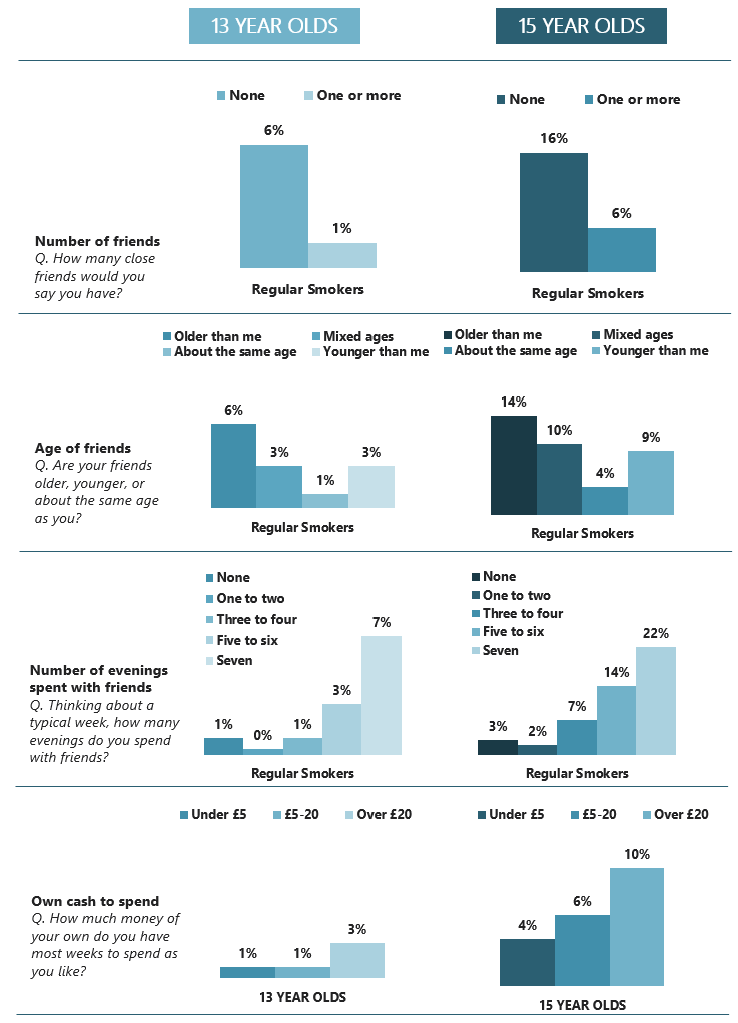
Base: all pupils (for full base sizes please see Appendix A)
Figure 7.3: Percentage of 15 year old pupils reporting taking part in leisure activities at least weekly, by smoking status (2018)
Q. Here is a list of things that young people sometimes do in their free time, when they aren’t at school. What about you?
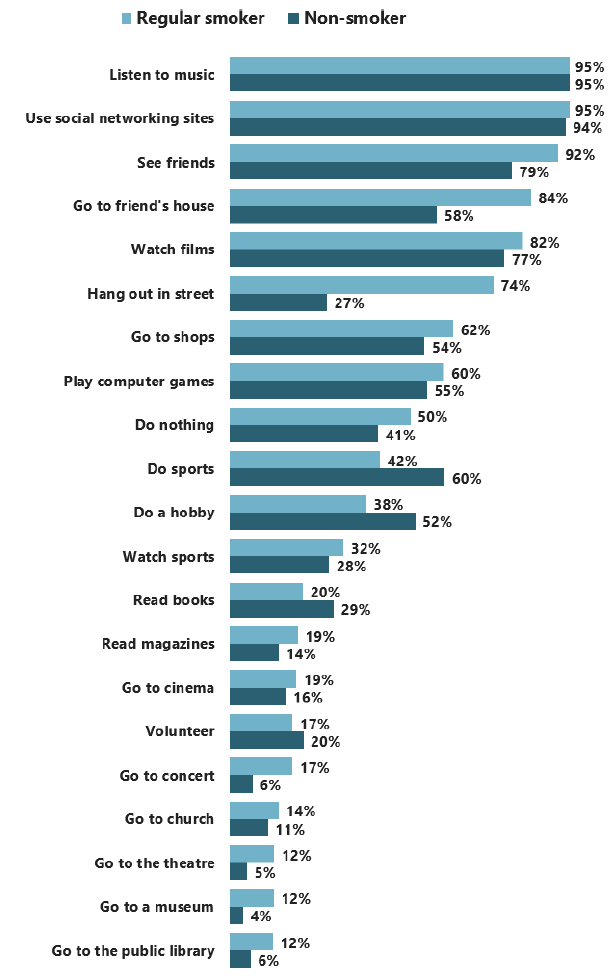
Base: all 15 year old pupils (for full base sizes please see Appendix A)
School
Factors relating to a pupil’s engagement with school were strongly associated with smoking. Key factors were: enjoying school, feeling pressured by schoolwork, exclusion from school, truanting and post-school expectations (Figure 7.4).
Enjoying school
Those who say they don’t like school at all are more likely to be regular smokers than those who don’t like it very much among both age groups. Among 15 year olds, students who like school a bit are less likely to be regular smokers than those who dislike school and those who like school a lot.
Feeling pressured by schoolwork
At age 13, those who felt pressured by schoolwork ‘a lot of the time’ were slightly more likely to be regular smokers than those who never felt pressured.
However, among 15 year olds, it was those who never felt pressured who were most likely to be regular smokers, more likely than both those who felt pressured sometimes and a lot of the time.
Exclusion from school
Across both age groups, pupils who had ever been excluded from secondary school were around five times more likely to be regular smokers than those who had not.
Truanting
Truancy was strongly correlated with regular smoking. Among both age groups, the more frequently a pupil truanted, the more likely they were to be a regular smoker.
Post-school expectations
Among 15 year olds, those that said they expected to go to university after school were less likely to be a regular smoker than those who expected to take a different path, such as going to college, working or doing an apprenticeship. 13 year olds who expected to go to university were less likely to be a regular smoker than those who believed they would start working straight after leaving school.
Figure 7.4: Comparison of prevalence of smoking, by factors relating to school and age (2018)
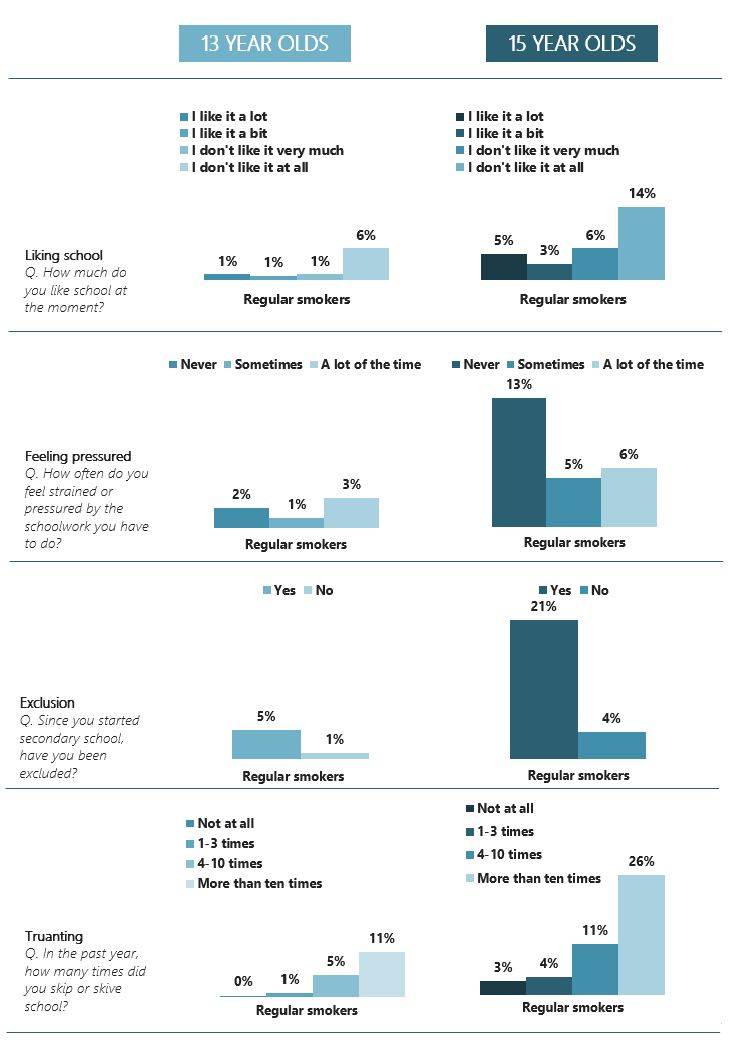
Figure 7.4 – continued – Comparison of prevalence of smoking, by factors relating to school and age (2018)
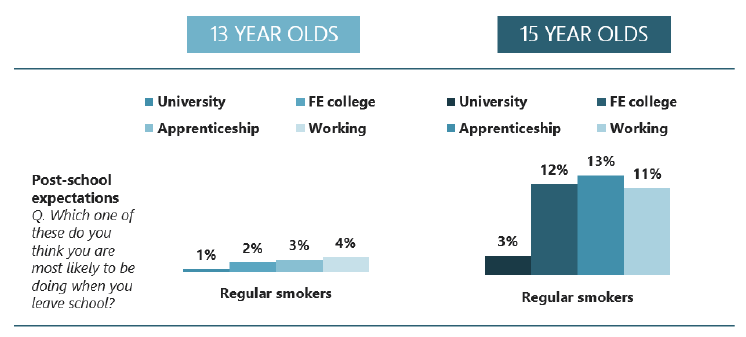
Base: all pupils (for full base sizes please see Appendix A)
Inequalities
Inequalities related to health and wellbeing had a strong relationship with smoking. These measures were: self-rated health, whether a pupil had an illness or disability, emotional and behavioural problems and mental wellbeing (Figure 7.5).
Self-rated health
Among both age groups, pupils who rated their health as ‘bad’ were more likely to be regular smokers than those who rated their health as ‘fair’ or ‘good’.
Long-term illness or disability
Pupils who said they had a long-term illness or disability were more likely to be regular smokers than those who did not.
Emotional and behavioural problems
Emotional and behavioural problems are assessed through the Strengths and Difficulties Questionnaire (SDQ) in SALSUS. This is a brief behavioural screening questionnaire that is designed for use with children and young people. The questionnaire contains 5 scales: emotional problems, conduct problems, hyperactivity problems, peer problems and pro-social behaviour. A score derived from the first 4 scales listed provides an overall indicator of emotional and behavioural problems.
Pupils with abnormal scores for emotional and behavioural conduct were more likely to be regular smokers than those with borderline or normal scores in both age groups. Among 15 year olds, those with borderline scores were also more likely to be a regular smoker than those with a normal score.[13]
Mental wellbeing
Mental wellbeing is assessed in SALSUS using the Warwick-Edinburgh Mental Well-being Scale (WEMWBS). This is a scale of 14 positively worded items, with five response categories. The scale is scored by summing the response to each item answered on a 1 to 5 Likert scale. The minimum score is 14 and the maximum is 70. The higher a respondent’s score, the better their mental wellbeing.
Among both age groups, those with below average mental wellbeing scores were more likely to be a regular smoker than those with an average or above average score.
Area deprivation[14]
Area-based deprivation is assessed using the Scottish Index of Multiple Deprivation (SIMD). This is used to provide an indication of material disadvantage in individual pupils.
There was not a strong pattern across different levels of deprivation.
Figure 7.5: Comparison of prevalence of smoking, by factors relating to inequalities and age (2018)
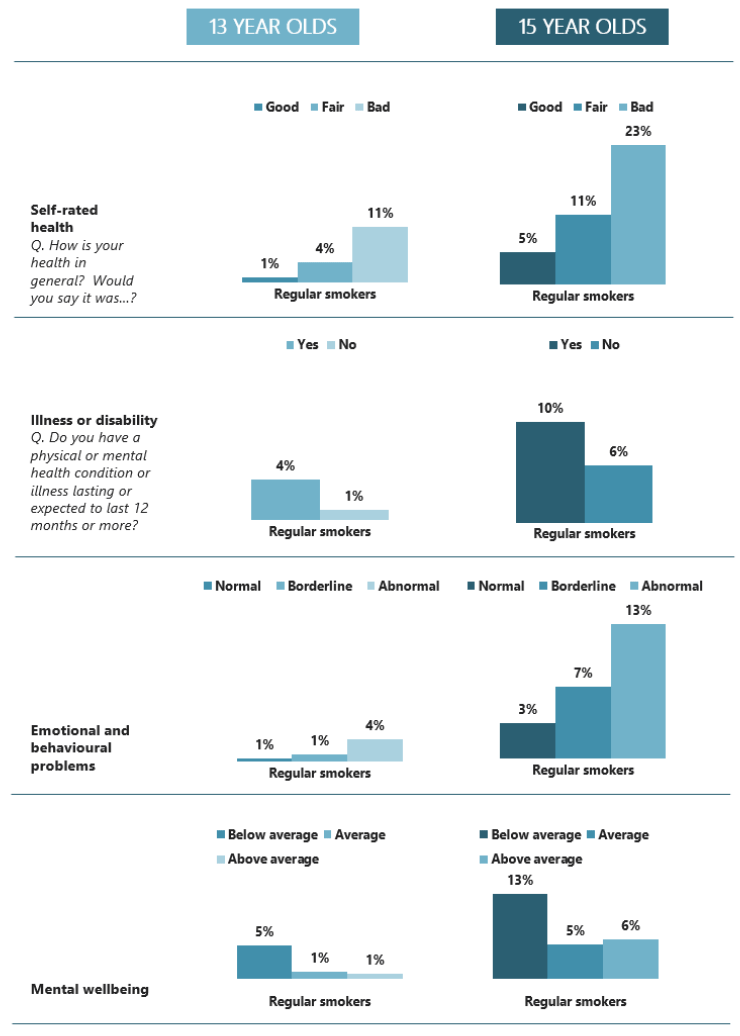
Figure 7.5 – continued – Comparison of prevalence of smoking, by factors relating to inequalities and age (2018)
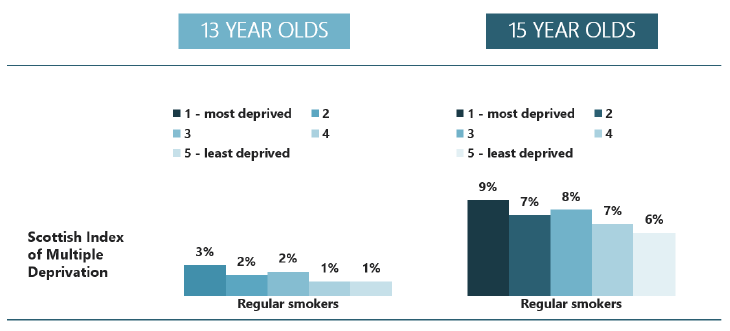
Base: all pupils (for full base sizes please see Appendix A)
Contact
Email: salsus@gov.scot
There is a problem
Thanks for your feedback